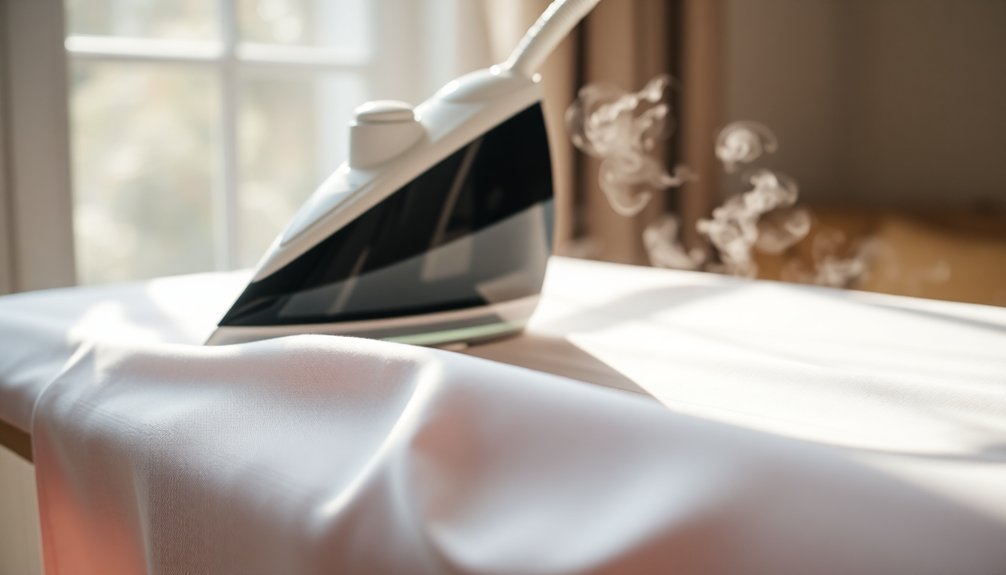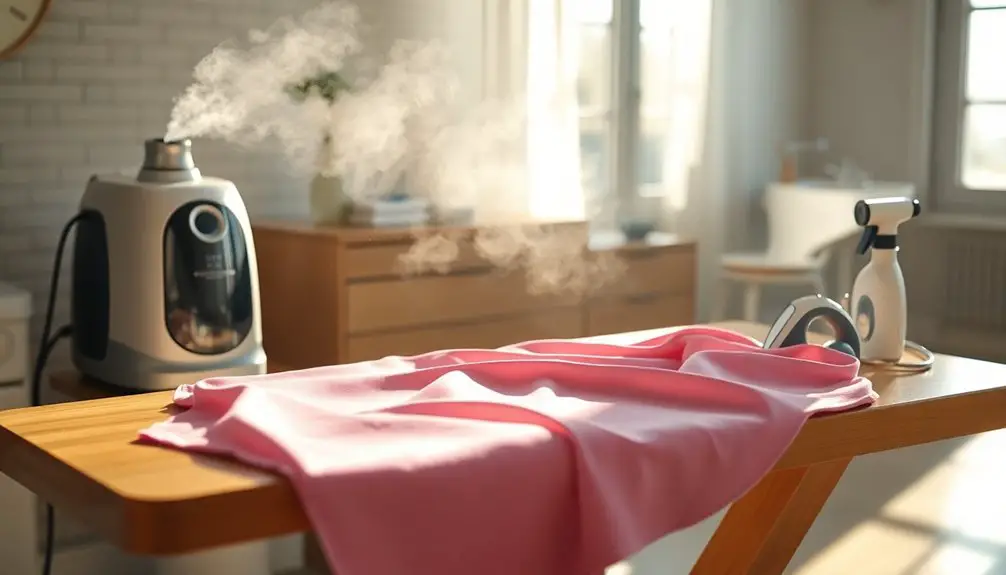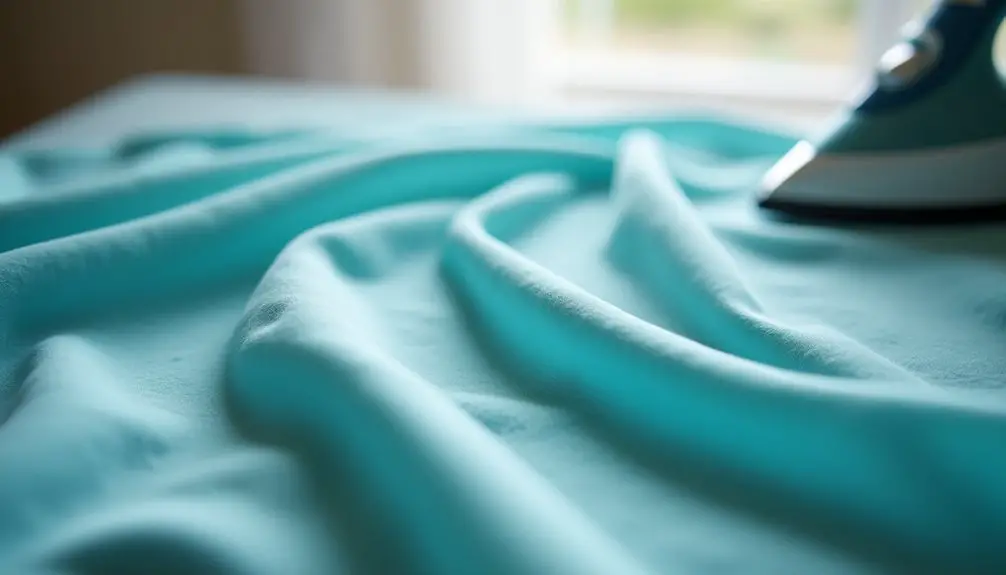To iron polypropylene fabric, keep it simple to maintain its wrinkle-resistant properties. Start by setting your iron to low heat, around 110°C. Always use a pressing cloth to protect the fabric from direct heat and prevent shine. Lightly mist the fabric with water before ironing to help release any wrinkles. Iron in sections with smooth, gentle strokes, and test a small area first for heat sensitivity. Remember, you don't need to steam it; just keep the heat low. If you're curious about other care tips and tricks for polypropylene, there's more to discover!
Key Takeaways
- Set the iron to a low heat of around 110°C to prevent melting the polypropylene fabric.
- Always use a pressing cloth to protect the fabric from direct heat and avoid shine.
- Lightly mist the fabric with water before ironing to aid in wrinkle removal.
- Iron in sections with smooth, gentle strokes for effective wrinkle reduction.
- Test a small area first to ensure the fabric's heat sensitivity before proceeding.
Understanding Polypropylene Fabric
When you think about durable and low-maintenance fabrics, polypropylene fabric often comes to mind. This synthetic material stands out due to its impressive strength, lightweight properties, and water resistance.
Whether you're considering outdoor gear or upholstery, polypropylene's versatility makes it an excellent choice. It's highly resistant to stains and moisture, which means you won't have to worry about frequent cleaning.
What sets polypropylene apart from natural fibers is its ability to resist wrinkles. Its unique molecular structure allows it to retain shape even after washing, making it a hassle-free option for everyday use.
If you do need to iron it, remember that using a low heat setting is crucial—high temperatures can cause the fabric to melt or distort.
When ironing polypropylene, it's wise to use a pressing cloth to protect the fabric. You can also use steam to help eliminate any stubborn wrinkles without direct contact.
This way, you can maintain the fabric's integrity while keeping it looking fresh. Understanding these properties will help you make the most of your polypropylene items, ensuring they stay durable and attractive for years to come.
Preparing for Ironing
Preparing your polypropylene fabric for ironing involves a few essential steps to ensure the best results. First, make sure the garment is clean and free of any stains; this prevents any stains from setting during the ironing process.
Next, check the care label for specific instructions, as some polypropylene items may have unique requirements.
Set your iron to a low heat setting, ideally around 110 degrees Celsius. Polypropylene is a synthetic fabric that's sensitive to high temperatures, and using too much heat can cause it to melt.
To further protect your fabric, use a pressing cloth between the iron and the polypropylene. This additional layer helps shield the fabric from direct heat damage and minimizes the risk of creating new wrinkles.
Before you start ironing, ensure your ironing board cover is clean and smooth. A well-prepared surface plays a crucial role in achieving even results.
With these steps completed, you're ready to tackle those wrinkles and achieve a polished look for your polypropylene fabric.
Ironing Techniques for Polypropylene

To effectively iron polypropylene fabric, you'll want to use careful techniques that protect the material while achieving a smooth finish. Since polypropylene is heat-sensitive, start by setting your iron to a low temperature, around 110 degrees Celsius. This prevents melting or damaging the fibers.
When you begin ironing, always use a pressing cloth. This protects the fabric from direct heat and prevents any shine or scorching.
To remove wrinkles effectively, employ a steam iron and lightly mist the fabric with water before ironing; this enhances wrinkle release.
Iron the fabric in sections, applying smooth and gentle strokes. Avoid over-ironing, as this can compromise the integrity of the material.
To ensure you're not causing any damage, always test a small, inconspicuous area first. This way, you can confirm that the iron's heat won't adversely affect the appearance or texture of the polypropylene fabric.
Care Tips for Polypropylene Garments
Caring for polypropylene garments is a breeze, thanks to their low-maintenance nature. These fabrics are inherently wrinkle-resistant, so you won't spend much time worrying about creases.
When ironing, always use a low heat setting, around 110 degrees Celsius, to prevent damage. It's a good idea to test a small, inconspicuous area first to ensure the heat doesn't cause melting or deformation of the fibers.
Avoid using steam when ironing polypropylene, as moisture can lead to unwanted creasing or shrinkage. Instead, use a pressing cloth for added protection during the ironing process. This will help maintain the integrity of the fabric and keep it looking sharp.
For optimal care, store your polypropylene garments in a cool, dry place, away from direct sunlight. Exposure to sunlight can cause fading and deterioration over time.
When washing, opt for a gentle cycle, similar to how you'd treat polyester fabrics, and avoid harsh detergents. With these care tips, you'll keep your polypropylene garments in excellent condition, ensuring they remain stylish and functional for years to come.
Alternatives to Ironing Polypropylene

Finding alternatives to ironing polypropylene can save you time and protect your garments. One effective option is using garment steamers, which can gently eliminate wrinkles without direct contact, minimizing the risk of damage from high heat.
If you don't have a steamer, consider the damp cloth method. Simply place a slightly damp cloth over the fabric and rub it gently with your hands to smooth out wrinkles.
Another great tip is to hang your polypropylene items in a steamy bathroom. The moisture helps relax the fabric, allowing it to look smoother.
When washing your garments, air drying is also beneficial. By hanging or laying them flat, you avoid the pressure of a dryer, which can lead to more wrinkles.
Additionally, try the rolling technique when storing your polypropylene clothes instead of folding them. This method can prevent creases from forming and keep your garments looking neat.
With these alternatives, you can effectively prevent wrinkles in your sensitive fabrics without the hassle of ironing.
Frequently Asked Questions
How Do You Get Wrinkles Out of Polypropylene Fabric?
To get wrinkles out of polypropylene fabric, use a steam iron on low heat, or lightly mist with water before pressing. Always test a small area first to avoid damage and protect the fabric's surface.
Can I Iron Polypropylene Fabric?
You can iron polypropylene fabric, but it's risky. Use a low heat setting and a pressing cloth to protect it. Always test a small area first to avoid melting or damaging the fabric.
How Do You Iron Wrinkle Free Clothes?
To iron wrinkle-free clothes, set your iron to low heat. Lightly dampen the fabric, use a pressing cloth, and gently glide the iron over small sections. Always test a hidden area first for safety.
Can You Iron Polyethylene Fabric?
You shouldn't iron polyethylene fabric, as high heat can cause it to melt. If you must, use a low setting and a pressing cloth. A garment steamer's usually a safer option for removing wrinkles effectively.

